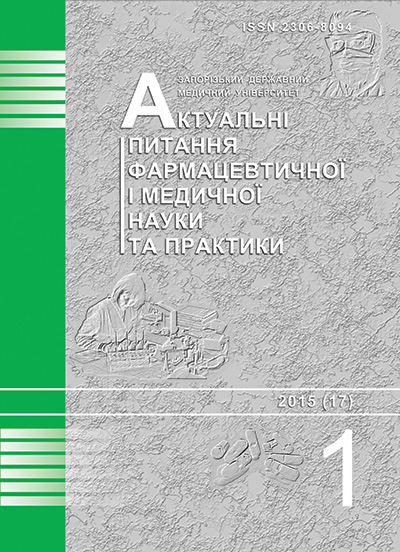Computer prediction of biological activity of 2-methyl(phenyl)-6,9-epoksybenzo[g]quinoline-4,5,10-Trion and 5-methyl-(1,2,4-triazolo[4,3-a] quinoline)
DOI:
https://doi.org/10.14739/2409-2932.2015.1.41644Keywords:
Forecasting, 1, 2, 4-triazole, Antineoplastic Agents, Anticonvulsants, Structure-Activity RelationshipAbstract
One of the priority measures, which are evaluated in the creation of new effective medicines, is their high selective effect and lack of side effects. A considerable interest is the possibility of combining several structures of heterocycles in one molecule, such as quinoline and furan, which may cause an increase in biological activity of these combined compounds or an emergence of new properties. It is known that derivatives of 1,2,4-triazolo[4,3-a]quinoline have anticonvulsant effect and treat the syndrome of disorders with the nervous system.
The aim of research. The main purpose of this work was an establishment of combinatorial library of bioregulators, which combines structures 5,8-dioksoquinoline and furan (1-8), quinoline and triazole (9-12), using computer program PASS (Prediction Activitity Spectra for Substances). Virtual screening of heterocycles derivatives was conducted to determine the direction of their bioactivity researches.
Materials and methods. The virtual screening of compounds was performed by using the computer program PASS (Prediction Activity Spectra for Substances). For the specific activity the increase of Pa quantity and the decrease of the Pi quantity, helps to get the greater chance to detect this activity in the experiment.
Predicting the probability of substance manifestation of specific types of biological activity determines which tests are the most appropriate for studying the biological activity of specific chemical substances and which substances of those that are available to the researcher likely will show the desired effect. With theoretical prediction the most likely basic structures of new compounds with desired biological effect, which best suits the task will be selected.
Results. Analysis of computer prediction demonstrates the promising search of antineoplastic, antibiotic, analgesic and other types of activity in some of these compounds. An important instant of prediction of these substances is their lack of high toxicity terato-, kantsero-, embryo- and mutagenicity.
The computer prediction of derivatives of triazole[4,3-a]quinolone had shown that the substitution of hydrogen on the carboxylic acid residue decreases the expected activity, but significantly expands its range and appears new types of biological activity. Injecting the propionic acid residue, you can observe an antieczematic activity, but injecting propylene - antiviral and antiinflammatory activities. Amidation of carboxylic acids leads to a decrease in the activity of "structure-leader" and the emergence of new activities, such as antineurotic, antinociceptive and muscle relaxant.
Conclusion. Data of the computer prediction shows us the promising search of the following two directions of bioregulators that can exhibit antineoplastic, antiradical, analgesic, antiinflammatory, diuretic and other biological activities.
References
Brazhko, O. A. (2003). Poshuk biolohichno aktyvnykh rechovyn sered 2- i 4-tiopokhidnykh khinolinu [Search bioactive substances of 2-and 4-thioderivatives of quinoline]. Visnyk Zaporizkoho derzhavnoho universytetu, 1, 120–126. [in Ukrainian].
Brazhko, O. A. (2005). Biolohichna aktyvnist pokhidnykh khinolinu ta akrydynu z azoto- ta sirkovmisnymy funktsionalnymy hrupamy (Dis… dokt. biol. nauk). [Biological activity of quinoline derivatives and acridine of nitrogen and sulfur-containing functional groups. Dr. med. sci. diss.] Kyiv. [in Ukrainian].
Chiasserini, L., Pellerano, C., Filippelli W., & Falcone G. (2002). Synthesis and pharmacological activity of 1,2,4-triazolo[4,3-a]quinolines. Il Farmaco, 56, 939–945. doi: 10.1016/S0014-827X(01)01166-1.
Brazhko, O. A., Omelianchyk, L. O., & Zavhorodnіi, M. P. (2004). Poshuk biolohichno aktyvnykh rechovyn sered amidiv ta hidrazydiv (khinolin-2-iltio- i 4-iltio)karbonovykh kyslot [Search bioactive substances of amides and hydrazides (quinolin-2-iltio and 4-iltio) carboxylic acids]. Zaporozhskij medicinskij zhurnal, 2(1), 39–42. [in Ukrainian].
Omelianchyk, L. O., Brazhko, O. A., Zavhorodnіj, M. P., & Kovalenko, D.S. (2004). Biolohichna aktyvnist' pokhidnykh 2- i 4-hidrazynokhinoliniv [The biological activity of derivatives of 2-and 4-hidrazynohinoliniv]. Visnyk Zaporizkoho derzhavnoho universytetu, 2, 108–112. [in Ukrainian].
Wei, C. X., Deng, X. Q., Chai, K. Y., Sun, Z. G., & Quan, Z. S. (2010). Synthesis and Anticonvulsant Activity of 1-Formamide-triazolo[4,3-a]quinolone. Derivatives Arch Pharm Res, 33(5), 655–662. doi: 10.1007/s12272-010-0502-0.
Chun-Bo, Zh., Chuan-Wen, Y., Xian-Qing, D., & Zhe-Shan, Q. (2011). Design and synthesis of 6-alkyoxyl[1,2,4]triazolo[1,5-a]quinazoline derivatives with anticonvulsant activity. Medicinal Chemistry Research, 21, 3294–3300. doi: 10.1007/s00044-011-9875-y.
Kolesnіkov, O. V., Chernykh, V., & Shemchuk, L. (2004). RASS-skryninh pokhidnykh pirymidynu [PASS –skryninh pyrimidine derivatives]. Aktualni pytannia farmatsevtychnoi ta medychnoi nauky ta praktyky Proceedings of the International Scientific Conference, (P. 192–199). Zaporіzhzhia. [in Ukrainian].
Filimonov, D. A., & Poroikov, V. V. (2006). Prognoz spektra biologicheskoj aktivnosti organicheskikh soedinenij [Prediction of biological activity spectrum for organic compounds]. Rossijskij khimicheskij zhurnal, 1(2), 66–75. [in Russian].
PASS Retrieved from http://www.ibmh.msk.su/PASS.
Downloads
How to Cite
Issue
Section
License
Authors who publish with this journal retain copyright and grant the journal right of first publication with the work simultaneously licensed under a Creative Commons Attribution License that allows others to share the work with an acknowledgement of the work's authorship and initial publication in this journal.


